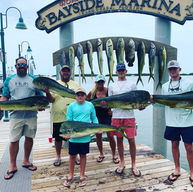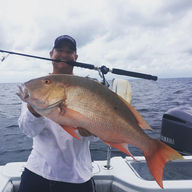Reef Fishing
The Florida Keys is home to the only living barrier reef in U.S. waters, stretching over 125 miles just five miles offshore. This vibrant reef supports one of the most diverse aquatic ecosystems on Earth, including numerous game fish species. Anglers will find a variety of Snapper—Yellowtail, Mutton, Red, and Mangrove—as well as several types of Grouper, including Black, Red, Gag, and even Goliath Grouper. The reef also attracts Barracuda and multiple shark species.
Fishing in waters 30–100 feet deep typically involves anchoring and creating a chum slick. Yellowtail Snapper gather in massive schools near the surface and are caught by free-lining small bait pieces. Mutton Snapper, Mangrove Snapper, and Grouper stay near the bottom and are targeted using live or artificial baits on fluorocarbon leaders. Predators like Barracuda and sharks often show up during the action.
Reef fishing in the Florida Keys offers nonstop excitement and variety for every angler. Choosing the right charter is key—Florida Keys Fishing Company provides top-tier boats, expert gear, and experienced captains ready to put you on the fish every time.

Reef Fishes in Islamorada
The reefs of the Florida Keys contain some of the most diverse aquatic life in the world. Some of the game fish species found on these reefs include Yellowtail Snappers, Red Snappers, Mutton Snappers, and Mangrove Snappers. We will also find Black Groupers, Red Groupers, Gag Groupers, and Goliath Groupers. The reef is also home to Barracuda, Amberjack, Wahoo, King Mackerel, and multiple species of sharks.

🐟
Amberjack

Amberjacks have a dark stripe (variably present) which extends from nose to in front of dorsal fin and “lights up” when fish is in feeding mode; no scutes; soft dorsal base less than twice the length of the anal fin base. Similar Fish: Other Seriola.
Where can you find them?
Offshore species associated with rocky reefs, debris, and wrecks, typically in 60 – 240 feet of water; sometimes caught near-shore in south Florida; juveniles associated with floating objects and may occur in water less than 30 feet deep.
-
Size: common to 40 pounds.
-
Florida Record: 142 lbs.
-
The largest of the jacks
-
Thought to spawn offshore throughout most of the year
-
Feeds on squid, fish, and crustaceans.
🐠
Yellowtail Snapper

Snapper’s back and upper sides are olive to bluish with yellow spots; lower sides and belly with alternating narrow, longitudinal pink and yellow stripes; prominent mid-lateral yellow stripe begins at mouth and runs to tail, broadening as it passes the dorsal fins; caudal fin yellow and deeply forked; no dark lateral spot. Similar Fish: none.
Where can you find them?
Juveniles inshore on grass-beds and back reefs; adults near-shore or offshore over sandy areas near reefs.
-
Size: common to 3 pounds.
-
Florida Record: 7 lbs., 5 ozs.
-
Found mainly in tropical waters
-
Spawns in midsummer
-
Rarely exceeds 30 inches and 5 pounds in size
-
Seeds on small fish and invertebrates.








